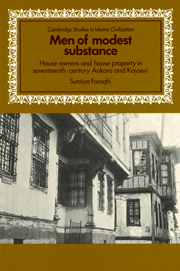Book contents
- Frontmatter
- Contents
- Tables
- Graphs
- Illustrations
- Figures
- Abbreviations
- Preface
- Introduction
- 1 Setting the scene: two cities of central Anatolia
- 2 The physical shape of urban houses
- 3 The cost of buying a house
- 4 Urban property-owners
- 5 The difficulties of an urban property-owner
- Conclusion
- Glossary
- Notes
- Bibliography
- Index
- Frontmatter
- Contents
- Tables
- Graphs
- Illustrations
- Figures
- Abbreviations
- Preface
- Introduction
- 1 Setting the scene: two cities of central Anatolia
- 2 The physical shape of urban houses
- 3 The cost of buying a house
- 4 Urban property-owners
- 5 The difficulties of an urban property-owner
- Conclusion
- Glossary
- Notes
- Bibliography
- Index
Summary
At some point in their careers, most historians become sensitive to the manner in which the craft they exercise might be of use in the ‘real world’. For the present author, growing consciousness in this respect has led to an interchange of ideas with architects, urban planners and restoration specialists at Middle East Technical University in Ankara, where I have been teaching for the past fourteen years. If an attempt was to be made to protect certain historical environments, it was obviously necessary to learn as much as possible about the environment to be protected. When referring to the contribution which might be made by a historian working mainly on the sixteenth and seventeenth centuries, this boiled down to three simple questions: how did Anatolian towns of this period function? what kinds of buildings did they contain? and how were the latter used? With an optimism largely due to inexperience, I set about finding the answers to these questions.
During the early stages, I was mainly concerned with the manner in which townsmen made a living. Translated into urban space, this involved a study of how the ‘business districts’ of Anatolian towns came into being. But peoples' lives do not solely consist of earning a living and, if one studies the scene on which Ottoman townsmen acted when they were not working, one's attention is automatically drawn to the often handsome houses which still exist in the more ‘traditional’ quarters of certain Anatolian towns.
- Type
- Chapter
- Information
- Men of Modest SubstanceHouse Owners and House Property in Seventeenth-Century Ankara and Kayseri, pp. xix - xxiiPublisher: Cambridge University PressPrint publication year: 1987

